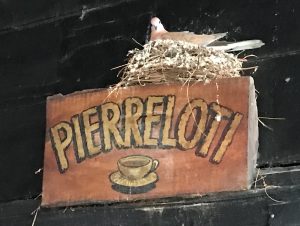 Tucked away at the far end of the Golden Horn, Eyüp is İstanbul’s most conflicted suburb, meaning one thing to most of its Turkish visitors and quite another to the foreigners. Tourists usually head for Eyüp with the romantic story of the 19th-century French writer Pierre Loti and his love affair with the mysterious Aziyade ringing in their ears. Turks, on the other hand, come here thinking of Eyüp el-Ensarı, the standard bearer and friend of the Prophet Mohammed, who died and was buried here during the Ummayad siege of what was then Constantinople in 668-9.
Tucked away at the far end of the Golden Horn, Eyüp is İstanbul’s most conflicted suburb, meaning one thing to most of its Turkish visitors and quite another to the foreigners. Tourists usually head for Eyüp with the romantic story of the 19th-century French writer Pierre Loti and his love affair with the mysterious Aziyade ringing in their ears. Turks, on the other hand, come here thinking of Eyüp el-Ensarı, the standard bearer and friend of the Prophet Mohammed, who died and was buried here during the Ummayad siege of what was then Constantinople in 668-9.
Such was his fame that Mehmed the Conqueror rushed to build (or more probably rebuild) a mosque on the site of his grave. This shrine came to play a hugely important role in the rituals surrounding the coronation of the sultans, with each new ruler processing here to strap on the sword of Osman, the first Ottoman sultan, thus confirming himself in office.
Today Eyüp still feels surprisingly self-contained, a villagey world unto itself with its twin poles, the shrine of Eyüp El Ansari and the teahouse where Loti used to sit and fantasise, separated from each other by a sprawling cemetery filled with wonderfully elaborate tombstones that gives it an unexpectedly rustic atmosphere.
Pierre Loti Cafe & Cemetery
To turn first to Pierre Loti, or Julien Viaud (1850-1923) as he was actually christened. Born in Rochefort in France in 1850, Loti joined the navy and travelled the world, spending the winter of 1876 in Constantinople where he set up home in Eyüp. It was there that he seems to have fallen in love with the Circassian wife of a wealthy merchant, an affair that inspired him to write his novel, Ayizade (although there are some who swear that Loti was actually gay and that Ayizade was a man).
Many of today’s visitors probably believe that they are drinking çay in front of the precise same teahouse as the writer although in fact his beloved cafe vanished long ago and has been replaced by a cosy imitation. The views, too, are much changed since Loti used to sit and admire them, although most will still find them satisfactorily spectacular, especially if they’ve swung up over the cemetery in the cable-car to reach the cafe.
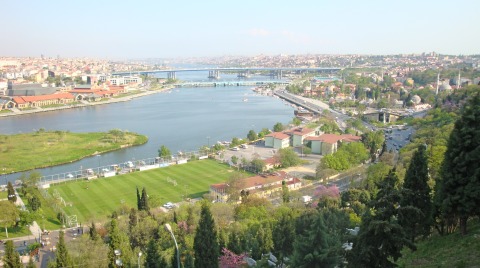 Modern view from Pierre Loti CafeEyüp Sultan Cami
Modern view from Pierre Loti CafeEyüp Sultan Cami
But Loti is a touristy distraction from the reality that is modern Eyüp where, on any given Friday, you can expect to see many small boys dressed in colourful satin and feather circumcision suits having been brought to this holy spot by their parents as part of the celebrations attached to their sünnet.
It would be hard to overstate the importance of the Eyüp Sultan shrine in the courtyard of the mosque which is always packed with people praying. The enormous külliye (mosque complex) has had to be rebuilt several times over the centuries, in particular following a massive earthquake in 1766. Despite its importance, the name of its original architect is unknown. Its hamam survives and is still in business.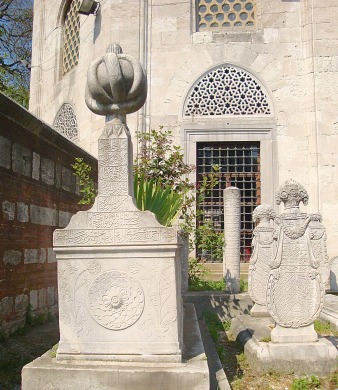
There’s a huge square in front of the mosque. Like Trafalgar Square it was once filled with pigeons who have now been corralled into a more hygienic coop to one side. This was apparently the site on which the Byzantine emperors would review their Varangian guard in the centuries after they had relocated from their palace in Sultanahmet to Blachernae.
Crowds press hard upon Eyüp Sultan Cami but the narrow tree-lined lanes around it can be virtually devoid of visitors despite housing the finest collection of Ottoman funerary art in the whole country. Not surprisingly, the richest and most powerful individuals vied with each other for the honour of being buried in the immediate vicinity of the mosque. This is where you’ll see the stand-alone tombs of mighty grand viziers such as Sokollu Mehmed Paşa (1505-79) and Siyavuş Paşa (1611-56). Lala Mustafa Paşa (1500-80), the ferocious conqueror of Cyprus, managed to bag himself space right inside the grounds of the mosque.
If you stroll along the alleys separating the tombs you will also pass hundreds of magnificent tombstones marking the graves of the next tier down in society. Most are topped off with stone turbans and fezes (for men) or carved with fruit and flowers (for women). Amongst those buried in Eyüp cemetery was the Samsun-born Circassian painter, Hüseyin Avni Lifij (1836-1927), who died in the Tayyare Apartments in Laleli. His tombstone faces the top of the funicular. Some of his paintings are on display in the Sakıp Sabancı Museum in Emirgan.
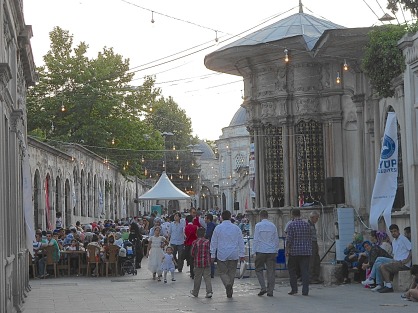 The Cülus Yolu just before iftar in Ramazan Almost lost amid all this splendour, the single most impressive street in Eyüp has to be Cülus Yolu (Accession Road), the route along which the new sultan would process towards the mosque after being deposited on the shore by his caique, the İstanbul take on a gondola. Today it’s easy to overlook its significance because the road running along the Golden Horn was later constructed on reclaimed land, leaving Cülus Yolu high and dry, its entrance completely severed from the water.
The Cülus Yolu just before iftar in Ramazan Almost lost amid all this splendour, the single most impressive street in Eyüp has to be Cülus Yolu (Accession Road), the route along which the new sultan would process towards the mosque after being deposited on the shore by his caique, the İstanbul take on a gondola. Today it’s easy to overlook its significance because the road running along the Golden Horn was later constructed on reclaimed land, leaving Cülus Yolu high and dry, its entrance completely severed from the water.
Visitors heading for the cable-car up to the Pierre Loti Cafe usually rush straight past without realising the significance of a road that is lined from end to end with magnificent marble walls but it’s well worth taking the time to stroll along it in the footsteps of the sultans.
If you do that you will probably be most struck by the glorious sebil (fountain) attached to the Mihrişah Valide Sultan complex, and by the adjoining İmaret, one of the last places in the city where soup was dispensed to the poor. You can even inspect photographs of the last sultans processing along Cülus Yolu on its walls, a thoroughly impressive sight.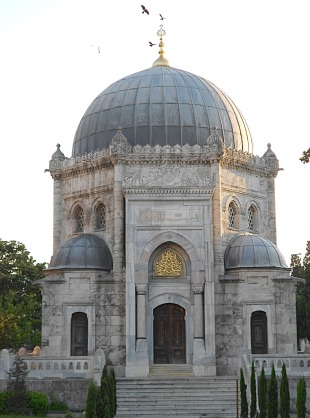
The last but one sultan, Mehmed V Reşad (1844-1918), was buried at the waterside end of Cülus Yolu. His renovated tomb can be seen right beside the local primary school which would once have had the Golden Horn lapping almost literally at its doors. Sadly, it’s never open to the public.
Returning to the centre of Eyüp you may want to admire some of the old wooden houses that have been restored and given a new lick of paint much like those around the Süleymaniye Cami. Here, too, you will find seemingly endless stalls selling religious items, including pretty little prayer rugs and fine rosaries made from a variety of materials.
South of Eyüp
By the time you’ve visited the mosque and inspected all the tombs you may be starting to feel that you’ve had enough of religious monuments for one day. Still, you should try and save a little energy to stroll back towards Ayvansaray along Feshane Caddesi because if you do that you will bypass the graceful 18th-century Şah Sultan complex and come to a truly spectacular work of Mimar Sinan in the form of the brick-and-stone-striped Zal Mahmud Paşa Cami, cleverly designed on split levels to fit a piece of sloping land.
The second most important mosque in Eyüp, Zal Mahmud Paşa is significant not so much for religious as for architectural reasons as it is a hugely impressive work of the great Ottoman architect Sinan dating back to the 1570s. Much of the complex also survives, including an upper and lower medrese, and the türbe (tomb) of the founder who was nicknamed Zal after a Persian hero.
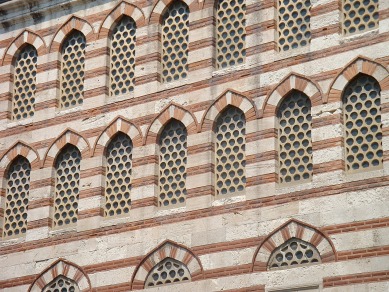 Mahmud is the man believed to have strangled Süleyman the Magnificent’s son, Mustafa, once the order for his death had been given. As a reward he was given İbraham Paşa’s palace in the Hippodrome that now houses the Museum of Turkish and Islamic Arts. Remarkably, Mahmud, and his wife, the daughter of Sultan Selim II, died on the same night in 1580; their tombs can be seen in the grounds.
Mahmud is the man believed to have strangled Süleyman the Magnificent’s son, Mustafa, once the order for his death had been given. As a reward he was given İbraham Paşa’s palace in the Hippodrome that now houses the Museum of Turkish and Islamic Arts. Remarkably, Mahmud, and his wife, the daughter of Sultan Selim II, died on the same night in 1580; their tombs can be seen in the grounds.
If you exit through the back gate of the Zal Mahmud Paşa Cami you will emerge close to the 16th-century Selahi Mehmet Efendi Cami, of interest mainly for a lovely hexagonal minaret topped off with a lantern.
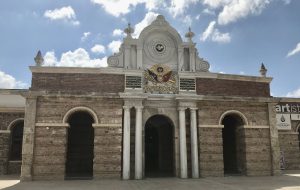
Feshane Caddesi takes its name from the long brick building overlooking the water. The Feshane, commissioned in 1833 by Sultan Mahmud II, was the workshop in which maroon-covered fezes were turned out by the thousands right up until 1925 when Atatürk decreed that henceforth every man should wear a şapka (hat). Not surprisingly it features in Jeremy Seal’s A Fez of the Heart, a journey round Turkey in search of the story of the fez. Today the Feshane ArtIstanbul is a lovely art gallery (closed Mondays, admission free) offering both permanent and changing exhibitions.
The tomb of Hüsrev Paşa (1584-1632), the man responsible for introducing the fez to Turkey from Tunisia, stands to one side of the Cülus Yolu.
If you continue to head east you will come to the small Cezari Kasım Paşa Cami (1515) where on a wall inside you can see a replica of a fine tile panel from 1726 showing Ottoman tents pitched around the Ka’aba in Mecca. Stolen from the mosque and then recovered, it is now on display in the Vakıf Eserleri Müzesi in Opera in Ankara.
Immediately beyond this is the 18th-century Defterdar Cami which has a pen and inkpot attached to its alem (the tip of the minaret) in memory of its calligrapher founder, Defterdar Mahmud Efendi.
Before leaving, glance across the Golden Horn to Sütlüce. The imposing building on the opposite shore with its twin turrets is the Haliç Kongre Merkezi (Golden Horn Conference Centre) housed in what was, until 1984, the city’s largest slaughter-house.
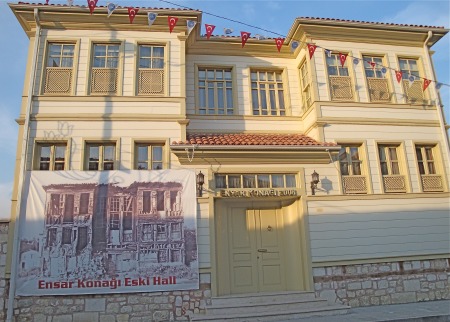 Ensar Konağı, restored in 2008Transport info
Ensar Konağı, restored in 2008Transport info
The nicest way to get to Eyüp is via one of the Golden Horn ferries from Üsküdar, Kadıköy or Karaköy. The funicular up to the Pierre Loti Cafe is just a short stroll away from the landing stage and it’s a pleasant walk back downhill through the cemetery to the centre of Eyüp.
The tram from Eminönü stops at Eyüp Sultan. Otherwise, frequent buses from Eminönü and Taksim travel along the southern shore of the Golden Horn to Eyüp.
Nearby areas
Read more about: İFTAR IN EYÜP
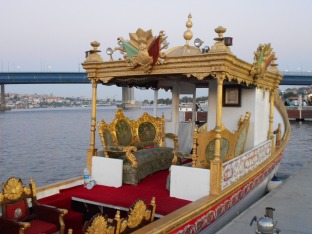 Replica of a sultan’s caique moored at Eyüp
Replica of a sultan’s caique moored at Eyüp

